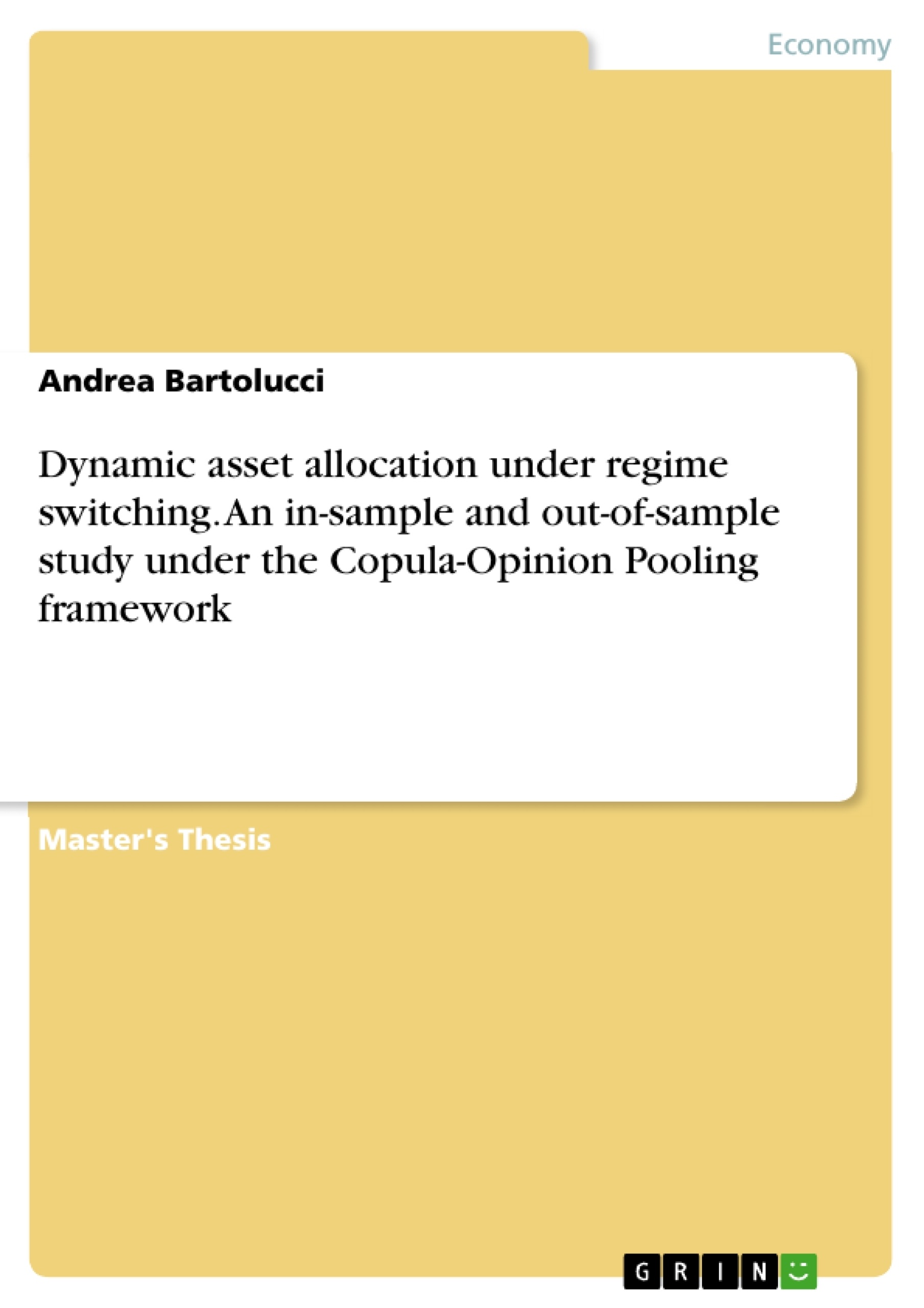My work consists of a comparative study of the performances of the multivariate regime switching model against the single regime model in terms of portfolio returns in the context of dynamic asset allocation. The study was conducted through the practical application, both in-sample and out of-sample, of the two models under various portfolio optimization approaches.
In the first part of the asset allocation exercise I constructed for any asset pricing model, both in-sample and out-of-sample, two dynamic recursive efficient portfolios that maximize the Sharpe among portfolios on the efficient frontier (one with opened budget constraint, one whose weights on risky assets must sum to 1); in addition short selling, thus negative asset class weights, is not allowed. The other three dynamic recursive portfolios that I constructed have been chosen as those that maximize the investor utility function with three different risk aversion coefficients subject to non-negative weights and opened upper budget constraint.
In the second part of the asset allocation exercise the Copula-Opinion Pooling approach is applied to implement in the asset pricing model views on the asset returns produced by both the single regime model and the regime switching model. The purpose of this section is to investigate and make a comparison of the behavior of the regime switching model and the single state model in the COP framework in terms of both expected and realized portfolio returns and Sharpe ratio in the context of mean-variance and conditional value-at-risk (CVaR) portfolio optimization.
The over-performance can be achieved by the more efficient and desirable risk-reward combinations on the state-dependent frontier that can be obtained only by systematically altering portfolio allocations in response to changes in the investment opportunities as the economy switches back and forth among different states. An investor who ignores regimes sits on the unconditional frontier, thus an investor can do better by holding a higher Sharpe ratio portfolio when the low volatility regime prevails. Conversely, when the bad regime occurs, the investor who ignores regimes holds too high a risky asset weight. She would have been better off shifting into the risk-free asset when the bear regime hits. As a consequence, the presence of two regimes and two frontiers means that the regime switching investment opportunity set dominates the investment opportunity set offered by one frontier.
Frequently asked questions
What is the main focus of this document?
This document is a language preview which comprehensively covers various aspects of asset allocation, particularly focusing on regime switching models and their effectiveness compared to single-regime models.
What key themes are explored?
The key themes include dynamic asset allocation, Markov regime switching models, multivariate time series analysis, portfolio optimization (mean-variance and CVaR), the Copula-Opinion Pooling approach, and analyzing the influence of economic factors like dividend yield and NBER recession indicators on asset returns.
What is the structure of the document?
The document is structured as follows:
- Introduction
- Literature Overview on regime-switching models
- Data description, including sources and descriptive statistics
- Model Estimation, including a theoretical background for Markov regime switching models and interpretation of results
- Asset Allocation, examining in-sample and out-of-sample performances based on various asset pricing models
- Asset Allocation based on the Copula-Opinion Pooling approach
- Conclusions
What kind of data was employed?
The data includes US small stocks (lo20), US large stocks (hi20), US Treasury bonds (tbond), the US 1-month T-Bill rate (risk_free), and the S&P 500 Dividend Yield (div_y). The time period under consideration is January 1965 – December 2010, followed by an out-of-sample period of January 2010 to December 2014.
What are the core objectives of the analysis?
The core objectives are to compare the performance of multivariate regime switching models against single regime models in the context of dynamic asset allocation and to investigate and make a comparison of the behavior of the regime switching model and the single state model in the COP framework.
What models are estimated?
Various Markov Switching Vector Autoregressive (MSVAR) models are estimated, including MMSIAH(k,p), MMSIA(k,0), MMSIAH(k,0), MMSIA(k,p), MMSIH(k,p), MMSI(k,p), and a multivariate restricted MSVAR(K,1) model. A single regime VAR(1) model is also estimated for comparison purposes.
What model selection criteria are used?
Akaike Information Criterion (AIC), Schwartz Information Criterion (SIC), Bayesian Information Criterion (BIC), and Hannan-Quinn criterion (HQC) are utilized to choose the best model specification.
What performance measures are examined?
The study examines Root Mean Squared Error (RMSE), Pearson correlation coefficient, regression analysis, expected portfolio returns, realized portfolio returns, and Sharpe ratios for portfolio performance comparison.
What is the Copula-Opinion Pooling (COP) approach?
The Copula-Opinion Pooling approach allows the investor to input views on the market, which are then combined with a prior market distribution obtained from the asset pricing model (MSVAR or VAR) to generate a posterior market distribution. This posterior distribution is used for portfolio optimization.
What are the key findings?
Key findings suggest the superiority of regime switching models against single-regime models due to their ability to capture economic regime changes. The investment portfolio performance heavily relies on the accuracy of asset returns forecasts, so a model that can account for relevant market features is crucial. However, there may be conflicting evidence of performance superiority from the two pricing models when analyzing Sharpe ratio or weights.
- Quote paper
- Andrea Bartolucci (Author), 2016, Dynamic asset allocation under regime switching. An in-sample and out-of-sample study under the Copula-Opinion Pooling framework, Munich, GRIN Verlag, https://www.grin.com/document/349755



